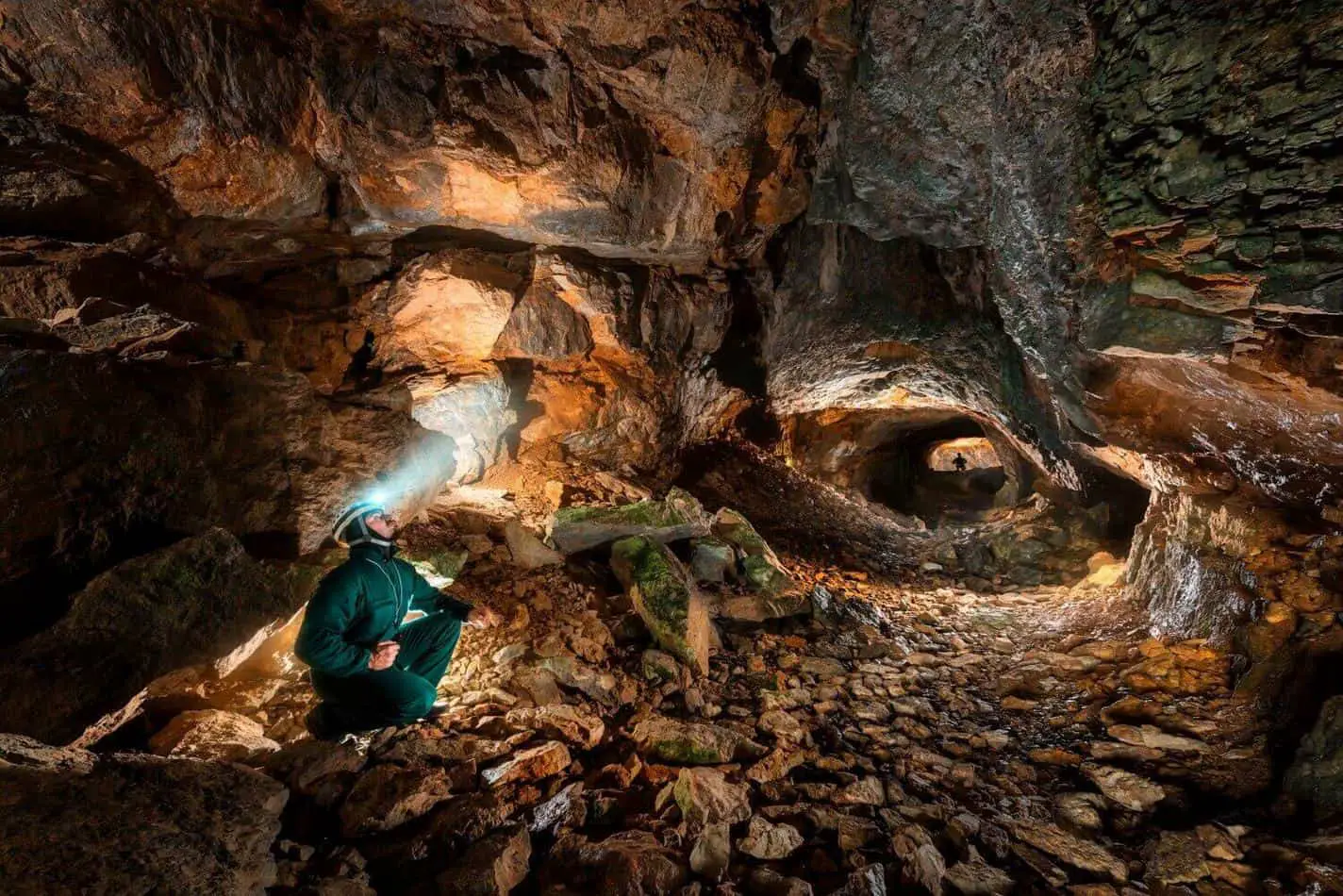I’m just getting into caving myself, and I remember typing into Google ‘How to get started caving?’ that first time. What to expect? It’s a fascinating sport and a bit mysterious, and it sure isn’t for everyone. It can be potentially dangerous if you’re not properly prepared. So, to make sure you are, I’ll give you a brief overview in this article. Is caving dangerous; what are the basic rules; and what should you definitely do before doing your first caving trip?
So as always: let’s dive right in.
In this article:
- What is Caving?
- So Tell Me, is Caving Dangerous?
- What’s Caving Like?
- What Techniques Do I Need to Know?
- What You Need to Know Beforehand
- What You Need to Do Beforehand
- Some Dangers You Want to Be Aware Of
- Safety Tips for First Time Cavers
What is Caving?
Caving is the recreational exploration of caves. Sometimes, caving is referred to as spelunking, though it’s not as solid a name as caving, as I’ve explained here in a previous post.
Is caving the same as the guided tour at the show cave park? No. It’s all about exploration. You go in with your buddies and get to know every inch of the cave before you move on. What’s the point of this? Some cavers map out previously unknown tunnel networks. But mostly, there is no point whatsoever. It’s about the exploration itself, and the experience.
Caves are impressive and humbling surroundings and hold interesting secrets and gems for you to explore.
So Tell Me, is Caving Dangerous?
The first thing most people want to know when you tell them you’re a caver, is: isn’t that dangerous? You’re right people, it’s unnatural to crawl through tiny underground passways. In fact, the most searched query on Google about caving is the number of caving accidents (well, not quite, but close enough). I get it: people are generally risk-averse. But I’d rather have dirty feet than to always keep my shoes on.
Caving isn’t particularly dangerous – if you keep some basic rules in mind and set out to be a sensible caver. But it can be dangerous if you don’t prepare well, or if you go off-grid and explore unknown cave tunnels without any backup.
As survival expert Ray Mears used to put it:
“Proper preparation prevents poor performance”
If you want facts, not opinions, I suggest you read my full article on how dangerous caving exactly is. In this article, I compare the odds of dying with those of bicycling, boxing, and mountain climbing. I also talk about ways to keep it safe.
What’s Caving Like?
So what’s caving like exactly? Well, first of all, caves are dark – very dark to be precise. So your field of view is very narrow since it’s limited to the range of your headlight. It’s humid, and you will get cold, and wet. The humidity gives off a funny smell, like old mushrooms.
You’ll probably walk more than you might think. Also, you will need to crawl and squeeze through tight spaces every now and then. Caves are tight, so you will get stuck, which is part of the fun. Just relax and breathe (think of it as getting hugged by Mother Earth). Take your time to free yourself. Your buddies are here to help you, might you need any assistance.
Some climbing can be required as well. See, in a cave, the layout is not man-made (or at least most of the time), so the path is dictated by mother nature. But that’s exactly where the fun is at.
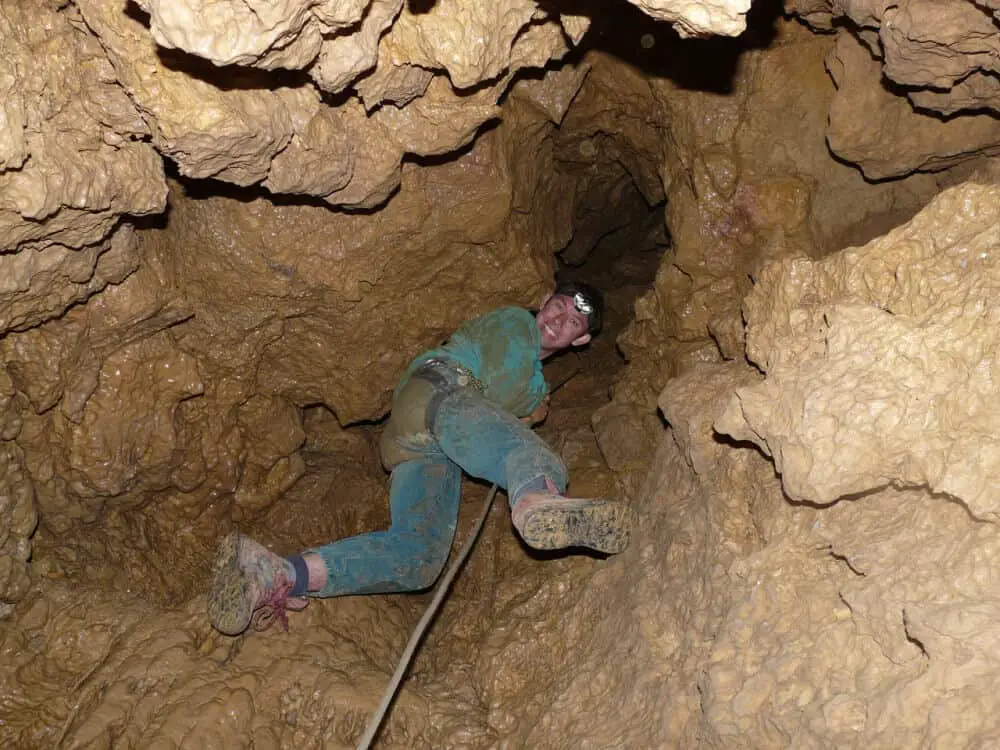
What Techniques Do I Need to Know?
In general, there are four types of caving:
- Dry caving
- Wet caving – requires some additional equipment and clothing, to keep warm and to have grip
- Vertical caving – requires climbing equipment and very good shoes
- Cave Diving – requires scuba equipment
Most caves offer a combination of three or even all four of these types of experiences. But cave diving is another ballpark. You need scuba equipment, lot’s of permits and licenses, and plenty of experience in order to safely dive a cave. Check out this bad boy:
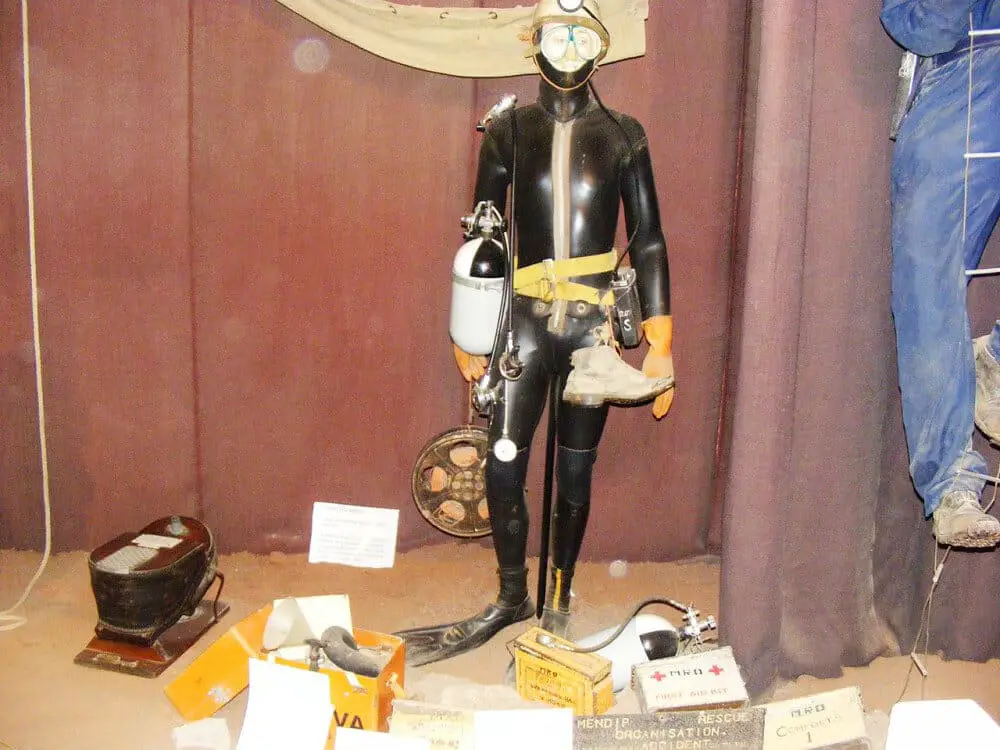
There are some basic techniques you’ll most likely end up using on most caving trips. You should absolutely be familiar with these before you go on your first trip. You don’t need to be a master of any; you’ll learn them on the fly. But you should have a general sense of what it takes to explore a cave, and how to approach different challenges along the way.
The basic caving techniques are:
- Walking – you’ll be walking a lot more than you think
- Crouching
- Hand-and-knees crawl
- Squeezes – pushing through a very tight corridor
- Chimneying – climbing up a narrow vertical passage with walls that nearly touch
- Traversing – travel across a cave passage sideways and at a height
- Ducking – submerging yourself in a stream where the cave roof touches the stream (called a duck)
- Sump diving – a free dive to pass the cave roof if it dips underwater (be advised: only sump dive when there’s a dive line to follow)
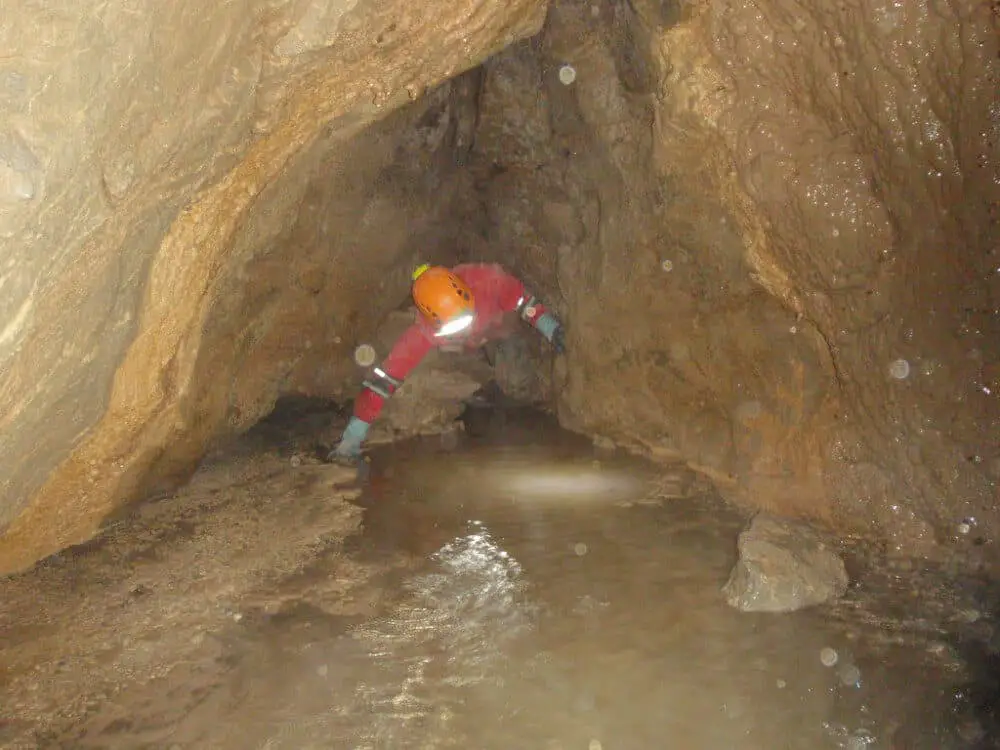
What skills do I need to have?
There are a couple of things you should definitely know (or you should bring someone who knows these things) before getting into your first cave:
- Know how to read a cave map
- Know how not to get lost
- Know how to survive in a cave
- Know how to improvise climbing gear
What You Need to Know Beforehand
So how do you make sure you’re properly prepared? You first need to know a couple of basic rules. The most important being: never go caving alone, especially if you’re new to this.
1. Never go alone
Responsible caving starts and ends with not going in alone. It’s really that simple. Being underground alone can result in some serious trouble. What will you do if you get hurt? Also, it’s generally more fun to not be alone.
That’s why sensible cavers use a buddy system. Ideally, your team consists of at least three people. This ensures that should someone get hurt, there’s someone to stay with the wounded, while the other goes to seek help.
Typically a team consists of five people. If you’re new to this (which I assume you are, since you’re reading this), make sure to stick around with somebody experienced. It will make all the difference in the world in whether your caving experience is ‘a fun and exciting experience’ or ‘a disastrous and teeth-clenching horror show’.
2. Carry at least three sources of light
The single most important thing while you’re underground is light. To make sure you’re never without it, you should always carry at least three sources of light. Preferably one of them can be mounted to your helmet. The other two can be regular flashlights. All of them should be battery or carbide powered and waterproof.
If you want to know what headlamps are good value for money, check out my recommendation here.
In most caves it’s wet, and you wouldn’t want to risk a blackout when you’re underground anyway. So please make sure to carry spare batteries as well.
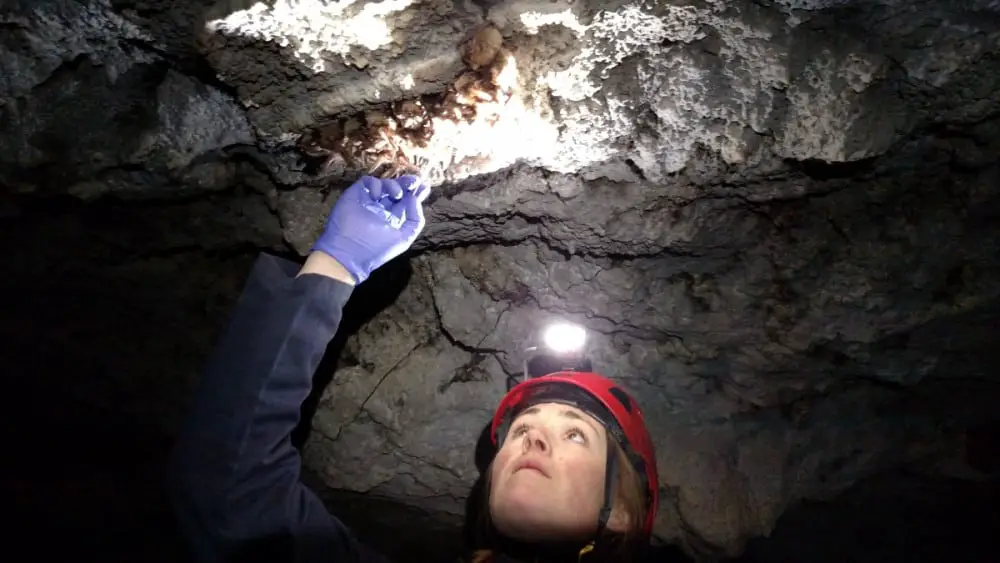
3. Know what to wear
Caves are not a comfortable environment. Caves are hard, sharp, mostly wet and slippery, and cold. Rocks will fall on your head. Proper clothing is very important. A basic caving outfit consists of:
- A hard hat/helmet – which you should never ever take off
- Multiple thin layers of clothing – ie. thermal underwear, long sleeves, and heavy-duty trousers
- Wear an overall – cave mud isn’t regular mud and won’t come out of your clothes easily
- Protective kneepads, elbow pads, and gloves – for squeezing and crawling
- Nonslip hiking shoes
So you’re heading for your first trip. Should you immediately buy all of this gear? No, I would recommend to instead rent the gear for the day. Most guided cave parks rent out hard hats for a small fee. For some guided trips it’s included in the price. Though, with most parks, you do need to bring your own lighting and clothes. I suggest you check with the park beforehand.
If you plan on caving regularly, owning a set of caving clothing is a good move. And it isn’t all too expensive. You should be done for about $300 – 400.
If you’re interested in buying your first gear I encourage you to read my Budget Buyer’s Guide. It gives you a great beginner packing list for $60, $150 and $300.
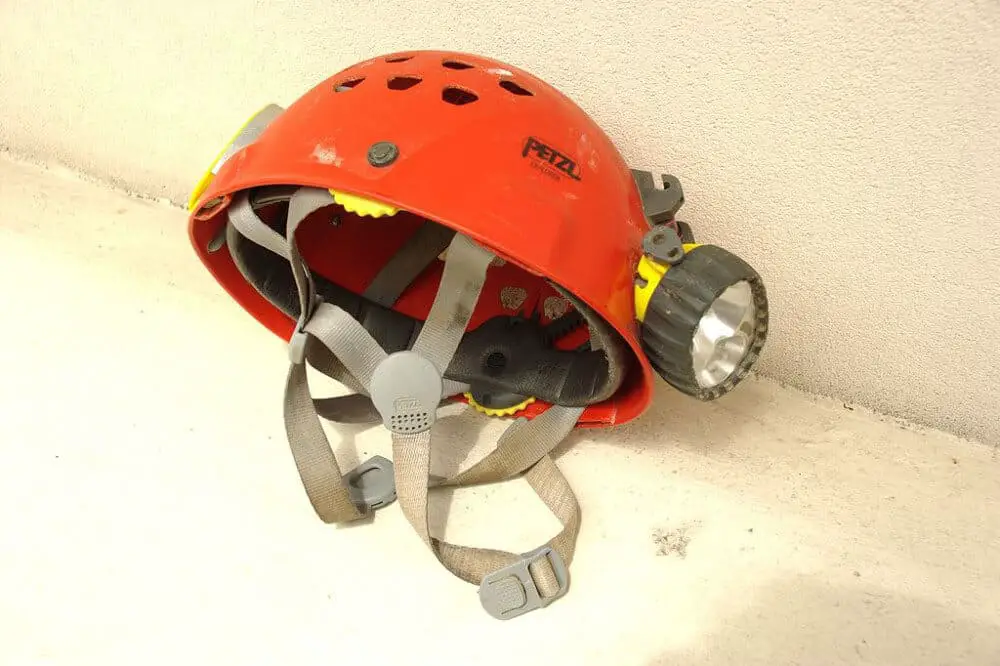
4. Pack wisely
Never has ‘travel light’ been more appropriate than now. You need to bring the right equipment to be safe. But on the other hand, you don’t want to be weighed down. Don’t save on gear: don’t bring any old, outdated or unreliable tools, but also don’t bring all of it. Bring what you need for this particular trip.
Bring food and water
Do make sure you bring enough food and water to last for at least a day, preferably two. If you bring a small water filter or purification tablets you can drink the water from the cave, allowing you to carry less water, which is heavy, so that’s good. But you should be very selective about which water you drink, and which you leave aside. Cave water can be infectious.
Bring a first aid kit
Someone should definitely bring a first aid kit and know how to use it. In case of trouble, stay clear of the cause. In other words: falling rocks? Get out of there before putting the bandaid on.
Bring clean clothes
This one’s so easy to forget. But believe me, the first time you crawl out of that hole – wetted, muddy, cold – you’re sure happy as a baby if you can change into some comfortable, dry clothes. Getting dinner afterward isn’t fun when you forgot your clean outfit. (I once went to a McDonalds on my socks).
5. Protect the cave
Caves are fragile ecosystems. It’s the home of the bat, who breeds and lives there. You should never damage or alter the cave; you should never leave your trash behind, and you should never disturb the bats.
Authorities require you to get a permit to protect the cave, not to haul in money. Which is why you should get a permit if it’s required to do so. I’ll get into permits further on.
6. Look back
Often, passages look different in the opposite direction. If you’re inexperienced, you can even get lost when you’re still quite close to the entrance. We’re used to recognizing structures from both directions, as were used to man-made architecture and landmarks. But caves are quite different.
So to make sure you’ll find your way back, look back every now and then, and take a mental image of the passage.
If you need to mark your route, don’t use string. A string is not a viable option. To mark a couple of miles you’ll need about 20 to 30 balls of string. Nobody’s doing that. Use reflective tape instead, and make sure to collect it again on your way out.
What You Need to Do Beforehand
Get permission
If you need permission, get it. Need to cross somebody’s land to enter the cave? Ask politely. Does the local government require you to get a permit? Get one. It’s not just to please others. By getting permission you get additional information on what’s out there, how safe the network is, and how you should handle it.
Permits
Permits are important. Local governments and caving associations don’t think them up to earn money (taxes are way more efficient), but to protect the cave. The way this works is simple: by getting a permit, you give the experts a chance to explain to you how to behave in the cave. By allowing them to give you information, you’re less likely to damage the cave in any way. So if it’s required to get a permit, please get one.
If you want to know how to get a permit, read our previous post ‘How To Get a Caving Permit‘.
Check if there’s a local rescue team
If you’re exploring a remote cave and there’s no support infrastructure, make sure your team knows how to act in case of emergencies, how to handle accidents, how to find their way out, etc. Ensure you bring along at least one experienced caver, preferably two.
Also, check if any incidents were reported lately.
Make sure your gear is proper
Reliable gear is key in challenging conditions. So make sure it’s reliable. You should check up on your gear before every caving trip, no exceptions.
- Is your helmet solid? – Once it has taken an impact, you should replace it. Helmets can’t take more than a couple of good impacts before cracking wide open. You don’t want that.
- Is your overall still in one piece?
- Are your pads and gloves still decent?
- Are your navigation tools functioning properly?
- Are your lights working and do you have working backup batteries?
Some Dangers You Want to Be Aware Of
Alright, maybe caving can be more dangerous than I’ve initially led you to believe. But I only did so because it’s real easy to avoid most serious hazards with the right knowledge and preparation. And I didn’t want to scare you away from the joys of caving, which are many.
To be properly prepared, you need to know about the following dangers:
You can get claustrophobic by doing it
No sh*t Sherlock, you might think. But there’s a reason I put this in here. Most people are slightly claustrophobic and aren’t even aware of it. How often do you find yourself cramped up in a space the size of a cardboard box? Right, I never found myself in that sort of situation; that is: until I went on my very first caving trip.
It’s no fun to figure out your claustrophobic when you’re belly-flat and stuck under a several-tonne-boulder. There are plenty of stories of people that have the big-time claustrophobia kick in right when they get in trouble underground.
It isn’t the end of the world either though. In fact, I encourage people not to overthink it and just go for it. Once you’re stuck in a cave, you need to find a way out. When you do find a way to free yourself, you’ve immediately overcome your claustrophobia for the most part. So not knowing and then dealing with it when the cave requires you to might be a good thing.
There are also plenty of tricks (including one old army trick) to overcome claustrophobia. I wrote a post on how to overcome claustrophobia.
So why do I tell you this? Because severe claustrophobia can kick you right into sixth gear and make you panic. And the one thing you don’t want to happen in a cave, where oxygen is low, humidity is high, and orientation is a problem, is getting a panic attack. So if you know that you’re pretty scared of tight spaces, please start with a straightforward tour in a show cave.
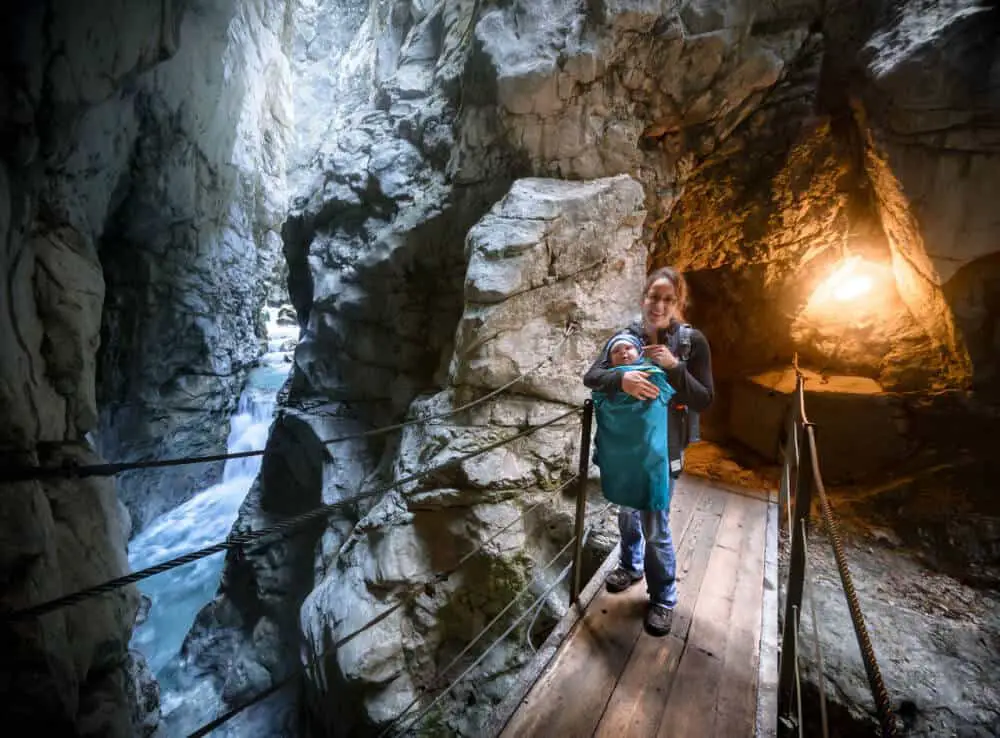
Hypothermia
When you’re in a cave for a long time, your body temperature can drop quite considerably. If your internal temperature drops rapidly below a certain point, your body can no longer warm itself, and life can no longer be sustained. This is called Hypothermia. It sounds quite severe, and it is, so you should really be aware of it.
It is essential that you’re able to recognize the symptoms of hypothermia, and that you know how to act when hypothermia kicks in. It also starts with shivering. Someone with hypothermia will most likely not be aware of his or her situation. The symptoms evolve gradually and prevent self-awareness.
The symptoms of hypothermia are:
- An intense feeling of cold and uncontrollable shivering
- Stiff muscles
- Slurred speech or mumbling
- Confusion
- Slow and shallow breathing
- Lack of coordination, clumsiness
- Weak pulse
- Very cold, blue hands and feet
If untreated, the person’s condition will deteriorate rapidly, resulting in coma, cardiac arrest, and possibly death. If you suspect someone suffers from hypothermia, you should do the following:
- Stop moving and let them rest
- Increase their body heat immediately
- Send someone out to get help
Falling rocks
In caves, occasionally rocks WILL fall. This is especially the case for unexplored networks. These tunnels haven’t been stabilized, so Mother Earth does it in her own way. That’s why you’re wearing the hard hat at all times. But even if you wear the hard hat while you get hit, you can sustain serious injury. If this is the case, your first priority is to get into safety. Do not stay in the same place, as there is a high chance of more rocks following.
Once into safety, evaluate your injury, treat it with the first aid kit and get someone to get help if necessary.
Flooding
Check with the landowner or the local authority whether or not the cave is prone to floods. Take this one very seriously. Cavers can get trapped, which is not a pleasant experience, or even worse. Check with local cavers and weather station to make sure the cave will stay reasonably dry.
More on the dangers
If you want a complete list of the dangers of caving, please go over to my article on how dangerous caving really is. The following tips and tricks for first-timers come from this article:
Safety Tips for First Time Cavers
If you’re going in for the first time, please remember the next simple rules to stay safe:
- Don’t exceed your limits – if you’re feeling exhausted, uncomfortable, claustrophobic, or anything of the things we’ve discussed: let others know. Don’t keep secrets in this environment. If you feel drained of energy, make sure to rest before continuing.
- Go in a group and stay together – the only excuse to split the group up is serious injury or emergency.
- Have an emergency plan – make sure everyone knows what to do in case of an emergency. Appoint a trip leader who will make the decisions in case of crisis. Only act without consulting the trip leader if you’re life’s endangered.
- Keep three points of contact – this rule goes as much for cavers as for climbers. When moving on rough terrain, always keep three points of contact. This will prevent you from slipping and falling, which is a major cause for (serious) injury.
- Take nothing but photos, leave nothing but footprints

